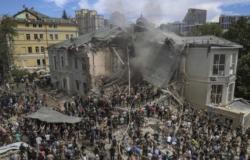The Georgian-Russian artist Zurab Tsereteli, known for his gigantic monuments already controversial, has died at age 91, reports the BBC. The sculptor, painter and architect born in Tiflis (Georgia) was controversial in almost each of his works.
Tsereteli reached fame during the Soviet era, leading the designer team for the 1980 Moscow Olympic Games, and later built large sculptures in cities around the world. Its proximity to the Russian political elite facilitated its success after the fall of the USSR. His relationship with Putin was more than cordial: on one occasion he said that the “healthy soul” of the Russian president had inspired him to carry out a bronze study of the Russian president.
Tsereteli was close friend of the mayor of Moscow, Yuri Luzhkov, and his position as part of the elite of the Soviet Union allowed him to travel abroad, where he met Pablo Picasso in Paris.
A figure for “La Paz”
The spokeswoman for the Russian Foreign Ministry, Maria Zajárova, said in a publication on social networks that the British public chain that Tsereteli was “a world -renowned artist, a public figure who did not know borders or obstacles when strengthening peace and supporting creativity.” “He will live not only in our hearts, but also in his works,” he added.
Despite the cold reception that his works sometimes received, Tsereteli was widely respected in the art world, and served as president of the Russian Academy of Arts. Its huge constructions can be found in cities around the world, such as the monument to Christopher Columbus in Seville, and the Chronic Monument of Georgia in its hometown, Tiflis.
-It also includes among its works the monumental tear of pain, of ten floors, in tribute to the victims of the attacks of September 11, 2001, which is in New Jersey. It was a gift from the Russian government to the United States.
The ‘Sant’ Jordi ‘of the United Nations headquarters
Getty Images
Sant Jordi in the UN
Another sculpture, good defeats evil, is at the United Nations headquarters in New York. It represents San Jorge killing a dragon, who lies among broken fragments of American and Soviet missiles.
According to the UN website, the work represents “the defeat of nuclear war through the historical treaty between the Soviet Union and the United States.”






